CATHEDRAL QUEST
Our quest to experience the great cathedrals and churches of Europe
U.K. 2013
EDINBURGH
Day 5, Saturday, September 7
We had a bit of excitement last night after we went to bed. The hotel’s fire alarm went off – it was a deafening sound. We put on our clothes, grabbed our passports, and walked down five flights of steps, out into the rain. After about 15 minutes, they announced that it had been a false alarm. The whole thing was rather unsettling.
When we got up this morning the sun was shining brightly into
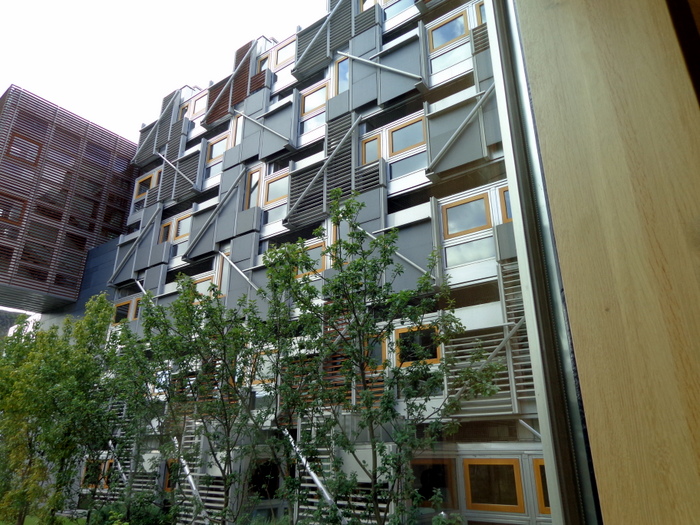 our room.
After another great breakfast, we took a taxi to the Scottish Parliament
building for a 10:30 tour. It is a very modern building which was built
in the 2004. There had not been a Scottish Parliament since its
adjournment on March 25, 1707. On September 11, 1997 the people of
Scotland voted in a referendum in favor of a Scottish Parliament. On May
12, 1999, the first meeting of the new Scottish Parliament took place.
our room.
After another great breakfast, we took a taxi to the Scottish Parliament
building for a 10:30 tour. It is a very modern building which was built
in the 2004. There had not been a Scottish Parliament since its
adjournment on March 25, 1707. On September 11, 1997 the people of
Scotland voted in a referendum in favor of a Scottish Parliament. On May
12, 1999, the first meeting of the new Scottish Parliament took place.
We were part of a group of 12 with a tour guide who showed us most of the building. There were a lot of interesting architectural designs, many of them being symbolic. The tour lasted a little over an hour.
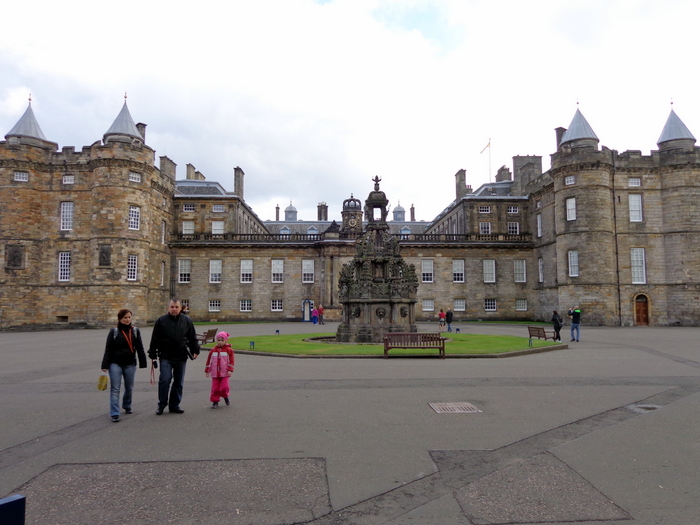 Across the street from the Parliament building is The Palace of Holyrood
House, which was on our list things to do today. Holyrood House has been
a royal residence for over 500 years. . The origins of the palace
lie in the foundation of an Augustinian Abbey in 1128 by David I. There
is an interesting legend which attributes the founding to King David's
vision of a stag with a cross or rood between its antlers. The name
Holyrood may also derive from the precious relic supposedly a fragment
of the True Cross, which had been brought to Scotland by David I's
mother, St. Margaret. The King dedicated his new religious foundation
to the Holyrood.
Across the street from the Parliament building is The Palace of Holyrood
House, which was on our list things to do today. Holyrood House has been
a royal residence for over 500 years. . The origins of the palace
lie in the foundation of an Augustinian Abbey in 1128 by David I. There
is an interesting legend which attributes the founding to King David's
vision of a stag with a cross or rood between its antlers. The name
Holyrood may also derive from the precious relic supposedly a fragment
of the True Cross, which had been brought to Scotland by David I's
mother, St. Margaret. The King dedicated his new religious foundation
to the Holyrood.
It was James IV (1488 –1513)-who decided to convert the
 royal
lodgings in Holyrood Abbey into a Palace. It was here that Mary Queen
of Scots lived. We visited the room where her husband, Lord Darnley,
Mary’ second husband, had Mary’s secretary, David Rizzio murdered.
Darnley thought something was going on between Mary and Rizzio. We had
audio guides for an interesting tour. Queen Elizabeth shows up every
once in a while. We were so hoping to see her!
royal
lodgings in Holyrood Abbey into a Palace. It was here that Mary Queen
of Scots lived. We visited the room where her husband, Lord Darnley,
Mary’ second husband, had Mary’s secretary, David Rizzio murdered.
Darnley thought something was going on between Mary and Rizzio. We had
audio guides for an interesting tour. Queen Elizabeth shows up every
once in a while. We were so hoping to see her!
HOLYROOD ABBEY
The tour of the
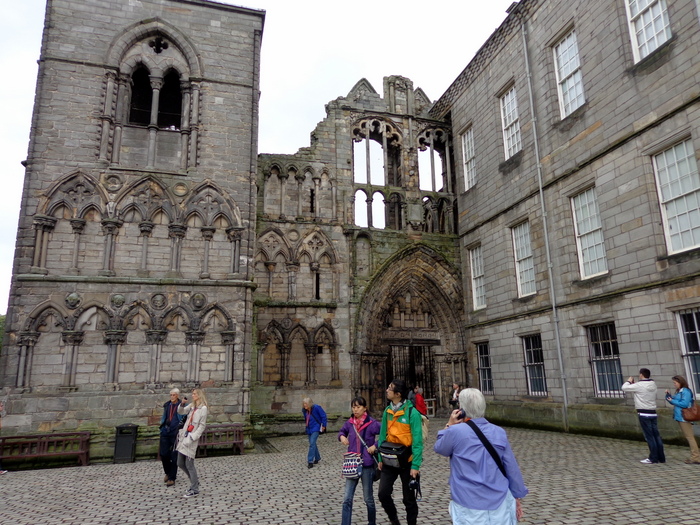 palace ended in the abbey ruins which were connected to
the palace. The tour of the palace ended in the abbey ruins which
were connected to the palace. The first church was too small and a new
building program was begun in 1195 and continued until 1230 to provide a
much larger more ambitious structure. Extensive monastic buildings were
added to accommodate the large community, including cloisters, a chapter
house, and refectory and guesthouses. The Abby was completed in 1250
but the stone vault caused problems from an early date, and in the 15th
century to levels of flying buttresses were added for support.
palace ended in the abbey ruins which were connected to
the palace. The tour of the palace ended in the abbey ruins which
were connected to the palace. The first church was too small and a new
building program was begun in 1195 and continued until 1230 to provide a
much larger more ambitious structure. Extensive monastic buildings were
added to accommodate the large community, including cloisters, a chapter
house, and refectory and guesthouses. The Abby was completed in 1250
but the stone vault caused problems from an early date, and in the 15th
century to levels of flying buttresses were added for support.

The Abby suffered badly in the 1540s from destructive raids by English armies, and the nave is all that remains today of the Abby's originals structure. The monastic buildings were abandoned after the Reformation and the Abbey itself suffered from extensive damage. The nave was the only part retain for use and in 1633 underwent major renovations. In 1688 it was ransacked by an Edinburg mob. In 1758 stone slabs were added to strengthen the roof but the extra weight hastened its collapse 10 years later leaving the abbey in ruins, which remains to this day. The ruins were very similar to what we experienced at Melrose Abbey yesterday. We spent about an hour looking at the ruins of Holyrood Abbey.
It started to rain so,we went into the Palace Café for lunch. We split a hamburger, about 4 french fries and a strawberry and cream scone.
 Adjacent to Holyrood is the Queen’s Galley. We had bought
a combination ticket. The exhibits change periodically. The present
exhibit was Leonardo Da Vinci – The Mechanics of Man.
Adjacent to Holyrood is the Queen’s Galley. We had bought
a combination ticket. The exhibits change periodically. The present
exhibit was Leonardo Da Vinci – The Mechanics of Man.
Around the walls
were fr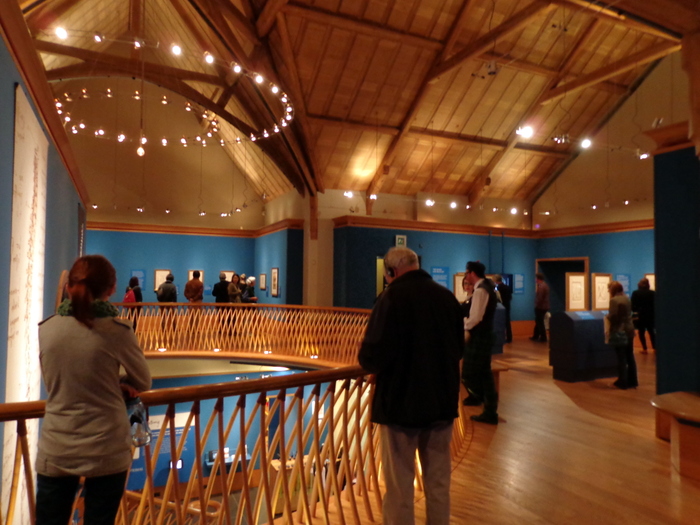 amed pages from Da Vinci’s drawing of various part of our
anatomy. Next to these drawing were modern 3 D photos of the same parts
of the body. It was a very interesting exhibit.
amed pages from Da Vinci’s drawing of various part of our
anatomy. Next to these drawing were modern 3 D photos of the same parts
of the body. It was a very interesting exhibit.
We had planned on seeing the Queen’s Yacht but it was 3:00 and it closed at 4:30, so we started walking back on the Royal Mile to our hotel. The streets were rather steep.
CANONGATE KIRK
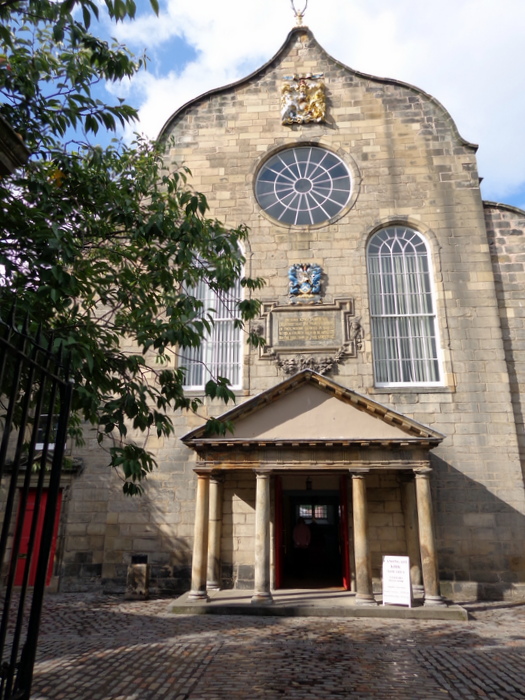 We stopped in a church named Canongate Kirk –a Presbyterian Church. King
James VII (and II of England) arranged for the parish church of
Canongate adjacent to the Palace of Holyroodhouse to become the Chapel
of the Order of the Thistle, and ordered that money left at the disposal
of the Crown by a merchant, Thomas Moodie, should be used to build a new
building, which was started in 1688, The interior of the building was
completely reorganised in 1817. A fire in 1863 did considerable damage
and, in 1882, another extensive alteration was carried out which
involved alterations to the galleries.
We stopped in a church named Canongate Kirk –a Presbyterian Church. King
James VII (and II of England) arranged for the parish church of
Canongate adjacent to the Palace of Holyroodhouse to become the Chapel
of the Order of the Thistle, and ordered that money left at the disposal
of the Crown by a merchant, Thomas Moodie, should be used to build a new
building, which was started in 1688, The interior of the building was
completely reorganised in 1817. A fire in 1863 did considerable damage
and, in 1882, another extensive alteration was carried out which
involved alterations to the galleries.
It was in 1938, the 250th
anniversary of the foundation of the present building that
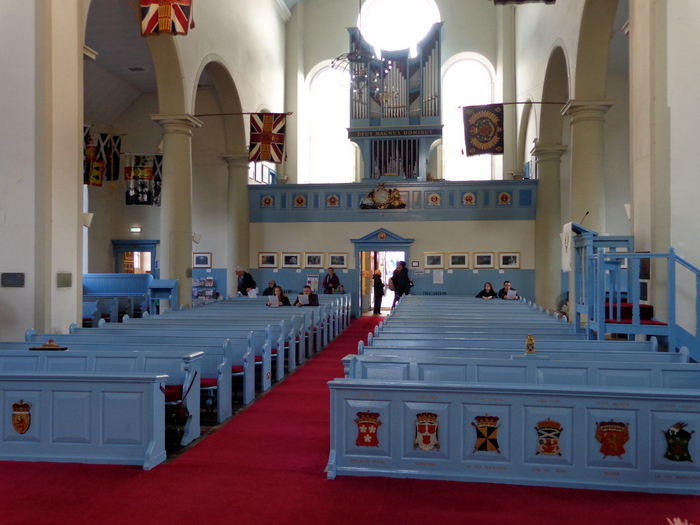 Dr Ronald
Selby Wright announced his plans for a revolutionary renovation.
Enough had been raised for a start to be made in December 1945.
The boldest change was the color scheme – the pews painted light blue,
the pulpit a darker blue, and the walls white. It was a lovely church,
and we were glad that we had an opportunity to spend some time in it.
Dr Ronald
Selby Wright announced his plans for a revolutionary renovation.
Enough had been raised for a start to be made in December 1945.
The boldest change was the color scheme – the pews painted light blue,
the pulpit a darker blue, and the walls white. It was a lovely church,
and we were glad that we had an opportunity to spend some time in it.
As we left, it started to rain again –hard, so we caught a taxi back to our hotel. It was about 4:30 so we decided to rest and eat dinner here at the hotel tonight. The weather has been very strange today, although the natives say it typical. It has been cold – in the low 50’s. It rains hard, then the sun comes out and the sky turns blue, a few minutes later it rains again.
We went down stairs to the Galvin Brasserie De Luxe for dinner. It is the same room in which we have breakfast. We had foie gras for a starter, Kathleen casselot (duck, sausage & lamb), I had a delicious sliced roasted chicken with summer vegetables and pasta in a broth. For dessert we shared a wonderful rice pudding.
NEXT DAY
PREFACE
Day 1 -Arrival in Edinburgh
Day 2 - Edinburgh
Day 3- Edinburgh to Inchcolm Abbey
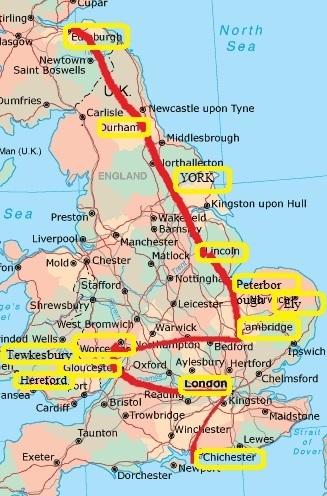
Day 4 - Edinburgh to Melrose & Rosslyn
DAY 5 - Edinburgh
DAY 6 - Edinburgh
DAY 7 - York
DAY 8 - Durham
DAY 9 -York
DAY 10 - Lincoln
DAY 11 -Ely
DAY 12 - Peterborough
DAY 13 - Cambridge
DAY 14 - Ely to Worchester
DAY 15 - Tewkesbury and Gloucester
DAY 16 - Hereford
DAY l7 - London
DAY 18 - London
DAY 19 - London
DAY 20 - London to Guildford, Chichester, Midhurst
DAY 21 - London OUR LAST DAY
HOME
